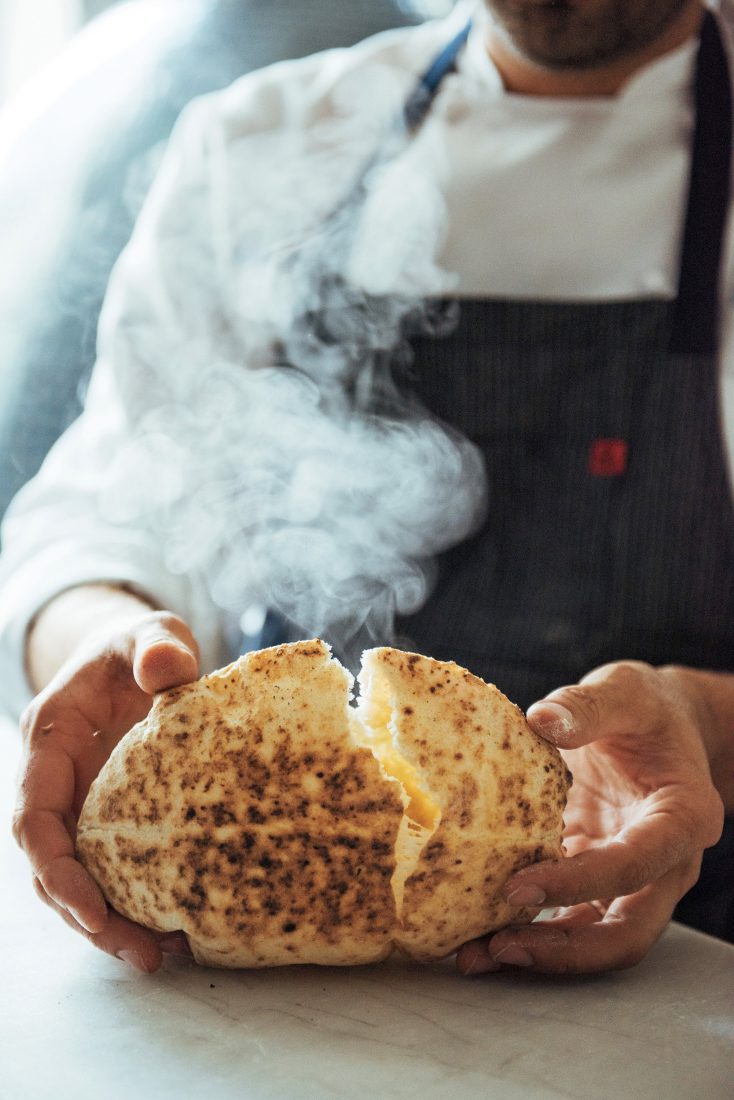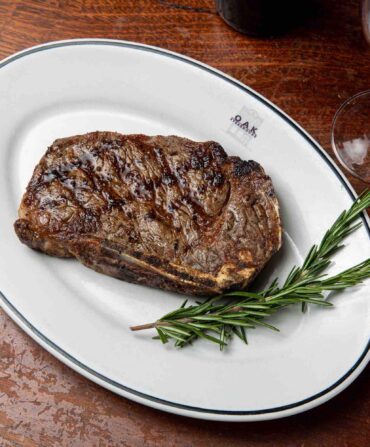Picture a helium balloon, hovering above a birthday party. Now wipe the saccharine colors and slogans and focus instead on the lightness and lift and irrational buoyancy of that latex sphere. Such an image will float into focus when an orb of pita, baked in a cerulean-tiled beehive oven and trailing sweet wood smoke, lands on your table at Shaya, the modern Israeli restaurant that Alon Shaya opened this past winter on Magazine Street in New Orleans.
For the briefest moment, the bisque-white bread wobbles, listing starboard as if overinflated, revealing brown and russet splotches gained on the deck of that oak- and pecan-fired oven. Tear a hunk from the outer wall, watch the poof of steam exhale, and swab the shard in a mix of olive oil and za’atar. Or drag it through the saucer of smoky baba ghanoush that arrives on a hammered tin platter, alongside a jumble of tabbouleh and toasted almonds brightened with preserved lemons, opposite a smear of hummus drizzled with tingly harissa and topped with a soft-cooked egg quarter.

Photo: Rush Jagoe
Chef Alon Shaya tends to the wood-fired oven.
The old joke was: There are a thousand restaurants in New Orleans but only fifteen dishes. Like me, you probably know and love the New Orleans roster, from oysters Rockefeller capped with a watercress puree to bananas Foster burning bright from wheeled gueridons. But when we weren’t looking, the city became a more expansive dining destination.
In the new New Orleans, the best steakhouse is an Argentinean clubhouse called La Boca, where the menu reads like a bovine anatomy thesis. The sandwiches everyone talks about are not po’boys but bánh mi, the French bread–based Vietnamese variations that the Tran family of Dong Phuong Bakery smear with pâté, stack with pork, and splash with fish sauce. And Shaya, the hottest restaurant in the city, serves a matzo ball soup that bobs with roasted duck and is so pleasantly redolent of anise that it tastes like someone sloshed a Sazerac in the pot.
A native of Tel Aviv, Alon Shaya grew up in Philadelphia and arrived in New Orleans to claim a casino steakhouse job with the chef John Besh. Before he opened Domenica, his first restaurant, Shaya spent seven months in Parma, Italy, learning pig butchery and how to cure a proper culatello. Israel may have been out of sight, but it was never out of mind. At Domenica, he hosted Passover seders. And he slipped dishes like shakshouka, a Middle Eastern casserole of fava beans, tomatoes, and eggs, into a menu heavy on Italian riffs like garganelli heaped with Mangalitsa ragu.
Shaya is a very personal restaurant. Alon cadged the recipe for lutenitsa, a Bulgarian red pepper spread, from his grandmother. His falafel is lighter than your average lump of fried chickpeas, owing to the whipped egg whites he folds into the dough. That’s a trick he learned frying hush puppies for family meal during his early days with Besh. But don’t think of Shaya as one of those nominally Middle Eastern fry houses that tack posters of sunny climes on the wall and bank their reputation on the gyro spit and the fry basket.

Photo: Rush Jagoe
The restaurant’s glowing dining room.
The vibe here is bright and airy and reflective of the reigning Exposed Brick Walls aesthetic. The tabletops are marble. The music is slow jazz. The food is elegant, comparably understated. Order the stuffed eggplant, roasted until the skin crackles, and it arrives packed with pearls of couscous and garnished with a pan-fried squash blossom. Local ingredients are plentiful. Get the kibbeh nayah and you savor a fluffy mix of minced beef and lamb from Two Run Farm, just across the border in Mississippi. Ask for labneh and you spoon into pepper-laced yogurt made from cows milked up the road at the Mauthe family dairy.
I once plotted New Orleans trips to eat my fill of French bread and all the dishes associated with it, from po’boys to whiskey-gilded bread pudding. After eating three meals at Shaya in five days, I predict a future when my New Orleans trips begin and end with a detour down Magazine Street. Sure, this city still runs on French loaves with cotton crumbs and parchment crusts. But tune in to the buzz now rattling the walls down here, and you recognize that Shaya represents a sort of future-tense New Orleans, where excellence is defined by a facility with Middle Eastern mezes as well as the Creole 15 repertoire.
One more thing to know before you cross the threshold: When you scan the Shaya menu, you won’t see pita listed. Don’t freak. There is no password to utter, no plea to make. Instead, a wobbly, piebald round arrives unbidden with every lunch or dinner order, puffed with steam, ballooned with promise.








